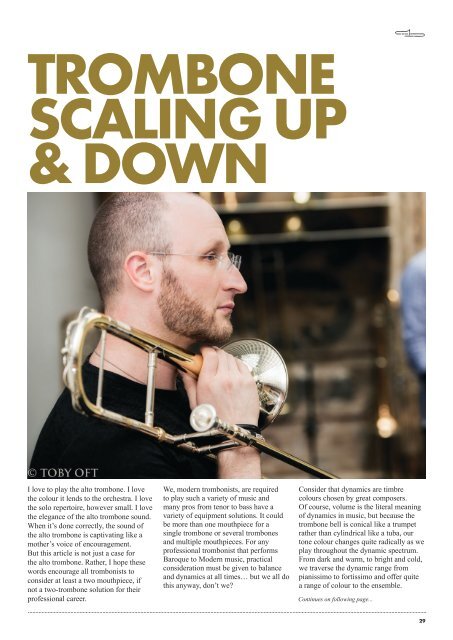FINAL MAG
Create successful ePaper yourself
Turn your PDF publications into a flip-book with our unique Google optimized e-Paper software.
TROMBONE<br />
SCALING UP<br />
& DOWN<br />
I love to play the alto trombone. I love<br />
the colour it lends to the orchestra. I love<br />
the solo repertoire, however small. I love<br />
the elegance of the alto trombone sound.<br />
When it’s done correctly, the sound of<br />
the alto trombone is captivating like a<br />
mother’s voice of encouragement.<br />
But this article is not just a case for<br />
the alto trombone. Rather, I hope these<br />
words encourage all trombonists to<br />
consider at least a two mouthpiece, if<br />
not a two-trombone solution for their<br />
professional career.<br />
We, modern trombonists, are required<br />
to play such a variety of music and<br />
many pros from tenor to bass have a<br />
variety of equipment solutions. It could<br />
be more than one mouthpiece for a<br />
single trombone or several trombones<br />
and multiple mouthpieces. For any<br />
professional trombonist that performs<br />
Baroque to Modern music, practical<br />
consideration must be given to balance<br />
and dynamics at all times… but we all do<br />
this anyway, don’t we?<br />
Consider that dynamics are timbre<br />
colours chosen by great composers.<br />
Of course, volume is the literal meaning<br />
of dynamics in music, but because the<br />
trombone bell is conical like a trumpet<br />
rather than cylindrical like a tuba, our<br />
tone colour changes quite radically as we<br />
play throughout the dynamic spectrum.<br />
From dark and warm, to bright and cold,<br />
we traverse the dynamic range from<br />
pianissimo to fortissimo and offer quite<br />
a range of colour to the ensemble.<br />
Continues on following page...<br />
29


